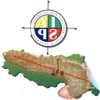Lymph Node Ratio as a Prognostic Factor in Patients with Pancreatic Endocrine Tumours
Abstract
Context The role of lymph node ratio (LNR) has been recognized as a prognostic factor in several malignancies. Objectives To evaluate the role of LNR in patients affected by pancreatic neuroendocrine tumors (pNETs). Methods Data regarding 45 patients were extracted from a dedicate database containing 92 patients undergone surgical exploration for pNETs. Patients who underwent palliative operation or enucleoresection or without Ki-67 determination were excluded. Sex, age, presence of symptoms, hormonal status, site of tumor, presence of MEN1, surgical procedure, R status, TNM-ENETS stage, WHO 2010 classification, Ki-67, and LNR were studied as possible factors influencing disease free survival (DFS) with univariate and multivariate analyses. Results Mean age of patients was 60±13 years. There were 22 (51.2%) female and 21 (48.8%) male. Symptoms were present in 27 (62.8%) patients. 34 (79.1%) patients had non-functioning pNETs and more frequently the tumor was located in the body (46.5%). Five (11.6%) patients were affected by MEN1. R0 resection was carried out in 38 (88.4%) cases. There were 17 (39.5%) pNETs G1, 24 (55.8%) pNETs G2 and 2 (4.7%) pancreatic neuroendocrine carcinomas (pNECs) G3. Mean Ki-67 was 6±10%. According to TNM-ENETS stage there were 17 (39.5%), 2 (4.7%), 17 (39.5%), and 7 (16.3%) patients in stage I, II, III, and IV, respectively. LNR was 0 in 26 (60.5%) patients, between 0 and 0.2 in 8 (18.6%) patients, and >0.2 in 9 (20.9%) patients. Mean DFS was 48±56 months. Multivariate analysis found that TNM-ENETS stage (HR 5.0; P=0.036) and Ki-67 (HR 1.2; P=0.016) were significantly related to DFS. There were no differences between patients with LNR=0 and LNR between 0 and 0.2 (HR 5.9; P=0.172) while patients with LNR between 0 and 0.2 had better DFS respect to those with LNR >0.2 (HR=0.2; P=0.01). A new cut off for LNR of 0.07 was obtained by ROC curve (AUC 0.771; P=0.008). Considering the new cut off, the multivariate analysis showed that LNR <0.07 was the only independent factor related to DFS (HR=28; P=0.002). Conclusion LNR can be considered an important prognostic factor predicting DFS in patients affected by pNETs.
Downloads
Copyright (c) 2014 Claudio Ricci, Francesco Monari, Salvatore Buscemi, Marielda D’Ambra, Davide Campana, Riccardo Panzacchi, Claudio Ceccarelli, Marcello Labombarda, Giovanni Taffurelli, Donatella Santini, Paola Tomassetti, Raffaele Pezzilli, Riccardo Casadei, Francesco Minni

This work is licensed under a Creative Commons Attribution 4.0 International License.
As a member of Publisher International Linking Association, PILA, iMedPub Group’s JOP follows the Creative Commons Attribution License and Scholars Open Access publishing policies. Journal of the Pancreas is the Council Contributor Member of Council of Science Editors (CSE) and following the CSE slogan Education, Ethics, and Evidence for Editors.
